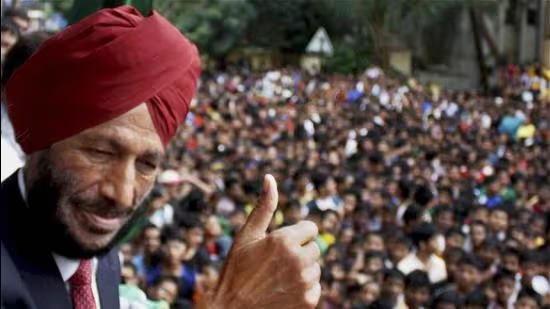Milkha Singh: A lot more than the sum of his records
To process what Milkha Singh still is to our sport, put an Indian athlete in the 400m final of the Tokyo Olympic Games. Then take away everything else around him. Precedent, tradition, resources, history even--no roots of a past and no perception of a possible future. Not only for themselves but the country he belongs to, newly-free but shackled by so much else. As he crouches low, all that lies before him is the athletic track curving into tomorrow.  PREMIUM
PREMIUM
Should that hypothetical Olympic finalist finish fourth today, he will be showered with ‘won hearts’ headlines and hashtags, acclaim and reward.
Also read | Milkha Singh cremated with full state honours
As time wore on from the Rome 1960 final, Milkha Singh’s moment at the Olympics began to be weighed down by the dream around it, rather than the enormity of its achievement. While the India of today as a sporting entity is decades away from its 1960s self, you cannot avoid the nagging reminder that our track athletes appear trapped by Milkha’s improbable history.
Milkha was India’s first Olympic track finalist, followed by only two men and one woman over the next six decades in individual events. (PT Usha was to make two finals, the 400m hurdles where she finished fourth in 1984 and the 4x400m relay.) Every athlete’s story gets overwritten by his successors but that has not happened either to Milkha or to Usha. Our field athletes have done better in the new millennium, with Anju Bobby George, Vikas Gowda and Krishna Poonia making it to an Olympic final, carrying the torch lit by triple jumper Henry Rebello in 1948.
Also read | Milkha Singh: That race in Rome, 1960
But it is the runner–turning metronomic striding and oxygen extraction into floating, fluid motion–that carries a country along with them. That was Milkha’s magic, not just when he competed but through his life, across generations, as an athlete and a sportsman.
In veteran Indian sports adminstrator Anthony De Mello’s 1959 Portrait of Indian Sport, Milkha appears first as “a pointer to a brighter future.” We learn that he “thrilled a big crowd” at the 1958 Tokyo Asian Games and was also India’s “hero of Cardiff” at the Commonwealth Games winning the 400m. “The memory of the occasion,” says DeMello, who was there, remains “one of the proudest in all my years’ experience in Indian sport.” It was to make Milkha, “an absolute icon” to Michael Ferreira.
Also read | Milkha Singh was gutted but we were so proud of him: GS Randhawa
The Tokyo Asian Games performances says Ferreira, “set our youthful hearts aflame building up to how he would do at the Olympics.” News of the 4th place finish in Rome came over the radio to “crashing disappointment”. The Olympic record he broke in Rome took a long time to be bettered by an Indian. Ferreira made his own name in Indian sporting history as multiple world billiards champion but kept running into Milkha over the years – always surrounded by a knot of people, always a star.
Milkha was at the heart of a golden generation of our country’s athletes, unofficial ambassadors of a free India. He was more than merely the sum of his records or his historic achievements, his life resonating and reached out across ages. Ferreira’s points out that Milkha’s commitment “times ten” to his sport, is what made him the phenom.
Also read | “Film on Milkha Singh got Pakistan talking about Abdul Khaliq”
In his hometown, Chandigarh, Milkha remained a colossus. He was to join the army and roomed with Jagir Singh Dhillon, who passed on Milkha stories – about the “times ten” method of unrelenting sweat – to a 13-year-old he had begun coaching many years later. That boy was Abhinav Bindra: “his work ethic, something he was so well known for, stuck in my mind. It was inspiring and important.”
This was the late 1990s, when in an ecosystem of scarcity, it was easier to give up on the hardships around Indian sport. To hear then that forty years before them, an Indian who refused to quit had matched the world’s best became a powerful light from a distant beacon.
There is another part of Milkha that appealed to Bindra, of the athlete unafraid to speak his mind, stand up for his convictions, a quality highlighted elsewhere in these pages. But if we needed to be reminded of how Milkha still matters, then the runners of Ichalkaranji, Maharashtra sent out a moving message. On June 13 and 14, in an athletic prayer for Milkha, more than 400 runners set out to run the total of 1920kms between Ichalkaranji and Chandigarh. At the end, they did more – a combined 3018km. It would have pleased the old champion.
Experience unrestricted digital access with HT Premium
Explore amazing offers on HT + Economist Start 14 Days Free Trial Already Subscribed? Sign In
Disclaimer: The copyright of this article belongs to the original author. Reposting this article is solely for the purpose of information dissemination and does not constitute any investment advice. If there is any infringement, please contact us immediately. We will make corrections or deletions as necessary. Thank you.







